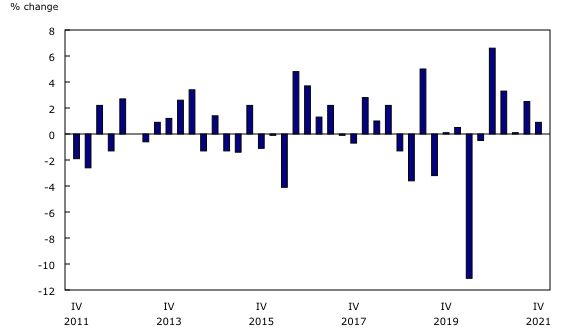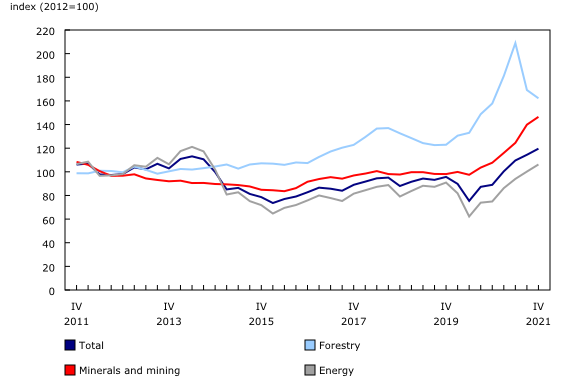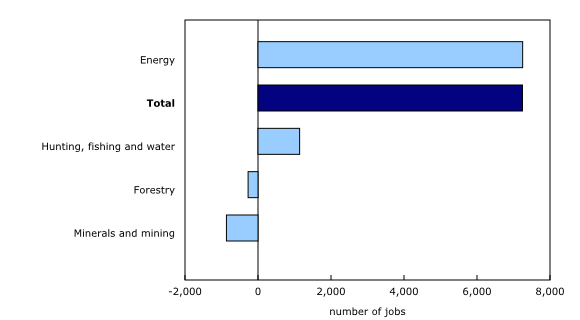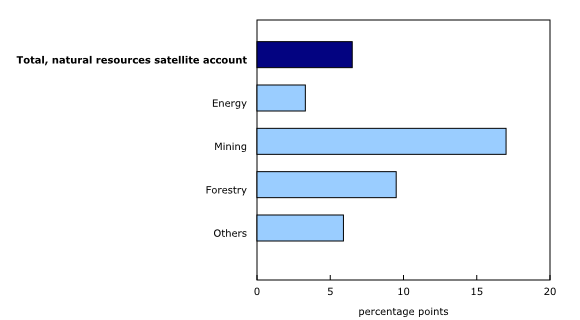Natural resource indicators, fourth quarter 2021
Archived Content
Information identified as archived is provided for reference, research or recordkeeping purposes. It is not subject to the Government of Canada Web Standards and has not been altered or updated since it was archived. Please "contact us" to request a format other than those available.
Released: 2022-03-24
Natural resources real gross domestic product rises in the fourth quarter
Real gross domestic product (GDP) of the natural resources sector increased 0.9%, after rising 2.5% in the third quarter.
In contrast, the economy-wide real GDP rose 1.6% in the fourth quarter.
Fourth quarter growth was driven mainly by the minerals and mining subsector (+2.0%). This was led by increased support activities for mining as new mines are being developed and the strength of copper, nickel, lead, zinc and potash mining.
Real GDP of the forestry subsector rose 0.5%, reflecting an increase in primary wood products (+13.4%) as producers increased production to meet international demand.
The real GDP of the energy subsector held steady (+0.4%) in the fourth quarter.
Quarterly export volumes rise, but import volumes decline
Natural resources export volumes increased (+2.1%) in the fourth quarter. Energy exports increased (+2.7%), led by refined petroleum products. Minerals and mining exports rose (+4.5%), driven by higher volumes of coal. Forestry exports fell (-7.8%), due to transportation disruptions in British Columbia caused by flooding.
Import volumes were down (-0.6%) in the fourth quarter, led by forestry (-3.1%). Minerals and mining declined (-1.4%) and energy imports increased (+0.3%).
Natural resource prices and nominal gross domestic product
Overall, natural resource prices rose 4.6% in the fourth quarter. Natural gas prices rose 17.5% due to increased demand and extreme weather events. Crude oil prices were up 9.5%, supported by Organization of the Petroleum Exporting Countries Plus (OPEC+) controls on the increase in supply as demand continues to rise.
The increased prices boosted growth in natural resources nominal GDP by 5.5% in the fourth quarter. Expressed as an annual rate, the nominal GDP of natural resources was $313 billion in the fourth quarter, representing 12.9% of the Canadian economy.
Employment increases
Employment in the natural resources sector rose 1.2% in the fourth quarter after increasing 1.3% in the third quarter. Jobs in the energy subsector increased (+7,300 jobs), while forestry (-300) and minerals and mining (-900) both declined. Hunting, fishing and water jobs increased (+1,100).
Downstream activities
For analytical purposes, secondary and tertiary processing for the forestry and the minerals and mining subsectors are identified separately. The nominal GDP of these downstream activities reached $9.3 billion in the fourth quarter, a 4.7% increase from the previous quarter. Prices increased 3.7% in the fourth quarter, following a 4.4% increase in the third quarter.
2021 in review
Compared with 2020, real GDP of the natural resources sector increased 6.5% and the economy-wide real GDP rose 4.6% for all of 2021. Compared with 2020, real GDP of minerals and mining (+17.0%), forestry (+9.5%) and energy (+3.3%) increased in 2021 as the economy recovers from lows caused by the pandemic.
Export volumes increased 4.0% in comparison with 2020 and import volumes fell 4.0% over the same period. From the fourth quarter of 2020 to the fourth quarter of 2021, employment rose 6.7% (+37,000 jobs).
Note to readers
Data on natural resources for the fourth quarter of 2021 have been released along with revised data from the first quarter to the third quarter of 2021.
The natural resource indicators provide quarterly indicators for the main aggregates in the Natural Resources Satellite Account (NRSA), namely, gross domestic product, output, exports, imports, and employment. The estimates from this account are directly comparable to the estimates in the Canadian System of Macroeconomic Accounts.
Core natural resources: The NRSA defines natural resource activities as those that result in goods and services originating from naturally occurring assets used in economic activity, as well as their initial processing (primary manufacturing).
Downstream activities: Although not part of the core account, natural resources have important downstream effects on other sectors. In general, this production uses a large portion of primary manufactured products as inputs.
Employment estimates reported in this release align with the noted definitions of natural resource subsectors. Consequently, these estimates may differ from those released by the labour productivity program.
Next release
Data on natural resource indicators for the first quarter of 2022 will be released on June 22.
Products
For more information on energy in Canada, including production, consumption, international trade and much more, please visit the Canadian Centre for Energy Information website and follow #energynews on social media.
The Economic accounts statistics portal, accessible from the Subjects module of the Statistics Canada website, features an up-to-date portrait of national and provincial economies and their structures.
Additional information can be found in the articles "The Natural Resources Satellite Account: Feasibility study" and "The Natural Resources Satellite Account – Sources and methods," which are part of the Income and Expenditure Accounts Technical Series (13-604-M).
The Latest Developments in the Canadian Economic Accounts (13-605-X) is available.
The User Guide: Canadian System of Macroeconomic Accounts (13-606-G) is available.
The Methodological Guide: Canadian System of Macroeconomic Accounts (13-607-X) is available.
Contact information
For more information, or to enquire about the concepts, methods or data quality of this release, contact us (toll-free 1-800-263-1136; 514-283-8300; infostats@statcan.gc.ca) or Media Relations (statcan.mediahotline-ligneinfomedias.statcan@statcan.gc.ca).
- Date modified:






